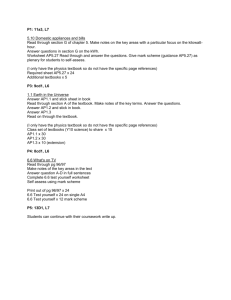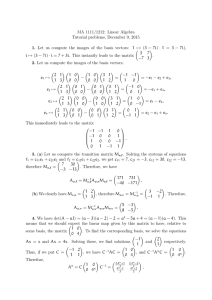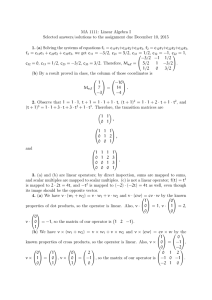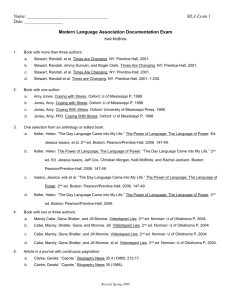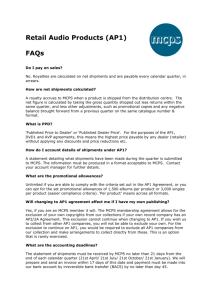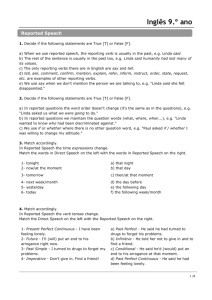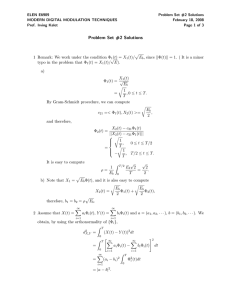APETALA1 and SEPALLATA3 interact to promote ¯ower development
advertisement
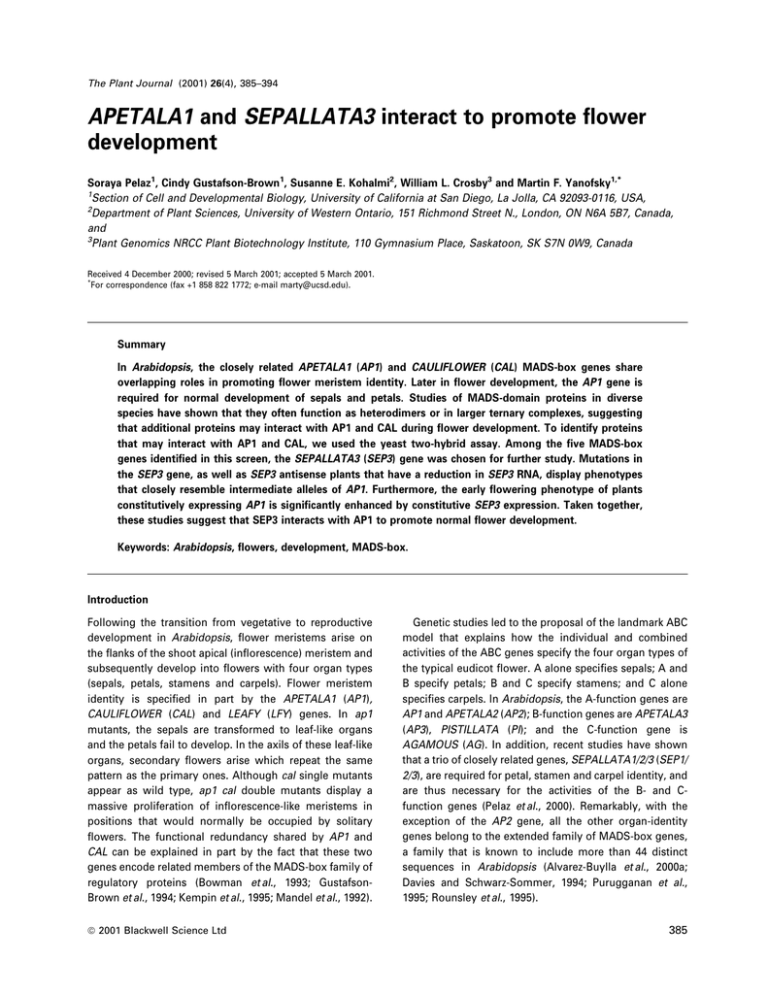
The Plant Journal (2001) 26(4), 385±394 APETALA1 and SEPALLATA3 interact to promote ¯ower development Soraya Pelaz1, Cindy Gustafson-Brown1, Susanne E. Kohalmi2, William L. Crosby3 and Martin F. Yanofsky1,* 1 Section of Cell and Developmental Biology, University of California at San Diego, La Jolla, CA 92093-0116, USA, 2 Department of Plant Sciences, University of Western Ontario, 151 Richmond Street N., London, ON N6A 5B7, Canada, and 3 Plant Genomics NRCC Plant Biotechnology Institute, 110 Gymnasium Place, Saskatoon, SK S7N 0W9, Canada Received 4 December 2000; revised 5 March 2001; accepted 5 March 2001. * For correspondence (fax +1 858 822 1772; e-mail marty@ucsd.edu). Summary In Arabidopsis, the closely related APETALA1 (AP1) and CAULIFLOWER (CAL) MADS-box genes share overlapping roles in promoting ¯ower meristem identity. Later in ¯ower development, the AP1 gene is required for normal development of sepals and petals. Studies of MADS-domain proteins in diverse species have shown that they often function as heterodimers or in larger ternary complexes, suggesting that additional proteins may interact with AP1 and CAL during ¯ower development. To identify proteins that may interact with AP1 and CAL, we used the yeast two-hybrid assay. Among the ®ve MADS-box genes identi®ed in this screen, the SEPALLATA3 (SEP3) gene was chosen for further study. Mutations in the SEP3 gene, as well as SEP3 antisense plants that have a reduction in SEP3 RNA, display phenotypes that closely resemble intermediate alleles of AP1. Furthermore, the early ¯owering phenotype of plants constitutively expressing AP1 is signi®cantly enhanced by constitutive SEP3 expression. Taken together, these studies suggest that SEP3 interacts with AP1 to promote normal ¯ower development. Keywords: Arabidopsis, ¯owers, development, MADS-box. Introduction Following the transition from vegetative to reproductive development in Arabidopsis, ¯ower meristems arise on the ¯anks of the shoot apical (in¯orescence) meristem and subsequently develop into ¯owers with four organ types (sepals, petals, stamens and carpels). Flower meristem identity is speci®ed in part by the APETALA1 (AP1), CAULIFLOWER (CAL) and LEAFY (LFY) genes. In ap1 mutants, the sepals are transformed to leaf-like organs and the petals fail to develop. In the axils of these leaf-like organs, secondary ¯owers arise which repeat the same pattern as the primary ones. Although cal single mutants appear as wild type, ap1 cal double mutants display a massive proliferation of in¯orescence-like meristems in positions that would normally be occupied by solitary ¯owers. The functional redundancy shared by AP1 and CAL can be explained in part by the fact that these two genes encode related members of the MADS-box family of regulatory proteins (Bowman et al., 1993; GustafsonBrown et al., 1994; Kempin et al., 1995; Mandel et al., 1992). ã 2001 Blackwell Science Ltd Genetic studies led to the proposal of the landmark ABC model that explains how the individual and combined activities of the ABC genes specify the four organ types of the typical eudicot ¯ower. A alone speci®es sepals; A and B specify petals; B and C specify stamens; and C alone speci®es carpels. In Arabidopsis, the A-function genes are AP1 and APETALA2 (AP2); B-function genes are APETALA3 (AP3), PISTILLATA (PI); and the C-function gene is AGAMOUS (AG). In addition, recent studies have shown that a trio of closely related genes, SEPALLATA1/2/3 (SEP1/ 2/3), are required for petal, stamen and carpel identity, and are thus necessary for the activities of the B- and Cfunction genes (Pelaz et al., 2000). Remarkably, with the exception of the AP2 gene, all the other organ-identity genes belong to the extended family of MADS-box genes, a family that is known to include more than 44 distinct sequences in Arabidopsis (Alvarez-Buylla et al., 2000a; Davies and Schwarz-Sommer, 1994; Purugganan et al., 1995; Rounsley et al., 1995). 385 386 Soraya Pelaz et al. MADS-domain proteins, well characterized in yeast (MCM1, Ammererer, 1990) and mammals (SRF, Norman et al., 1988), form dimers that bind to DNA and form ternary complexes with many unrelated proteins (Lamb and McKnight, 1991; Shore and Sharrocks, 1995). A number of studies have shown that heterodimers and ternary complexes of plant MADS-domain proteins can occur and, given the overlapping expression pattern of numerous MADS-box genes, such interactions greatly increase the regulatory complexity of MADS-box genes (Davies et al., 1996; Egea-Cortines et al., 1999; Fan et al., 1997). The regulatory speci®city of these genes is achieved through protein±protein interactions and not through different intrinsic DNA-binding speci®cities (Krizek and Meyerowitz, 1996; Shore and Sharrocks, 1995). MADS-box proteins are composed of four different domains, designated M, I, K and C. The MADS (M) domain is highly conserved among these proteins, and is responsible for binding to DNA in addition to its participation in homodimer formation of some proteins. The I region also participates in homodimer formation (Krizek and Meyerowitz, 1996; Riechmann et al., 1996). Adjacent to the I region is the K domain, so named due to its similarity to the coiled-coil domain of keratin. It is absent in the nonplant proteins, and has been implicated in protein±protein interaction (Fan et al., 1997; Krizek and Meyerowitz, 1996; Mizukami et al., 1996; Moon et al., 1999; Riechmann et al., 1996). The C-terminal region has been proposed to be involved in transcriptional activation (Huang et al., 1995), and also to play a role in the formation of ternary complexes (Egea-Cortines et al., 1999). In order to identify candidate proteins that interact with AP1 and CAL, we used a modi®ed version of the yeast twohybrid system (Bartel et al., 1993; Chien et al., 1991; Fields and Song, 1989; Fields and Sternglanz, 1994; Kohalmi et al., 1998). These screens resulted in the isolation of ®ve MADS-box genes as well as two additional genes. Here we present the results of these screens, as well as the molecular and genetic analyses of one of these interacting genes, SEP3. Our results suggest that the observed interactions in yeast re¯ect functional interactions that occur in plants. Results Proteins that interact with CAL Yeast two-hybrid screens were performed to identify candidate genes whose products interact with AP1 and CAL. Using a full-length CAL cDNA as bait, 23 interacting clones were identi®ed, rescued from yeast and transformed into Escherichia coli. Sequence analyses showed that they fell into four classes, all previously identi®ed as AGAMOUS-like (AGL) genes (Figure 1a). The ®rst class, SEP3, included four clones all of which began within the I region. Because the cDNA library was poly (T) primed, the clones all comprised varying lengths of the 3¢ end of the gene. SEP3 is ®rst expressed in the central dome of stage two ¯oral primordia, and is maintained in the inner three whorls of the ¯ower (Mandel and Yanofsky, 1998). SEP3 acts redundantly with SEP1 and SEP2 and is necessary for the development of petals, stamens and carpels (Pelaz et al., 2000). The second class identi®ed was the SUPPRESSOR OF CO OVEREXPRESSION 1 (SOC1) gene, and included seven clones. The starting point of these clones varied. One clone began with the ATG start codon, another started near the end of the MADS box, and the remaining clones started at 5¢ ends of the I region. SOC1 is expressed in the in¯orescence meristem, as well as in the two inner whorls of the ¯ower beginning in late stage two, and is involved in promoting ¯owering (Samach et al., 2000). The third class was the SHORT VEGETATIVE PHASE (SVP) gene, and included four clones. Of the clones from this screen, one started in the MADS box and three began in the I region. SVP was identi®ed as an Arabidopsisexpressed sequence tag with homology to the MADS-box family (Alvarez-Buylla et al., 2000a), and was also cloned by Hartman et al. (2000) through transposon tagging. SVP is a repressor of ¯owering and is expressed in young leaves and throughout the shoot apical meristem during vegetative development. After the transition to ¯owering, it is expressed in young ¯ower primordia until stage 3 (Hartman et al., 2000). The last eight clones were identi®ed as AGL24. One of these clones began within the MADS box and three within the I region. In addition, the 5¢ ends of four clones lie in the ®rst third of the K box, representing the shortest clones isolated in the screen. AGL24 was ®rst identi®ed in a previous yeast two-hybrid screen as a clone that interacts with AG (S.E.K. and W.L.C., unpublished results; AlvarezBuylla et al., 2000a). AGL24 is expressed in in¯orescences and young ¯oral primordia. To con®rm the speci®city of the observed interactions, the longest and shortest clone of each class was transformed back into a yeast strain that contained either the CAL bait; the bait vector; or an inert control bait, cruciferin. The strains containing the CAL bait tested positive for both b-Gal activity and HIS prototrophy. The strains containing the bait vector or the cruciferin bait were negative in both assays, as they were not able to grow on plates lacking histidine and the yeast colonies were completely white in the b-Gal assay (not shown). AP1 forms dimers in yeast with CAL interactors The structural and functional similarities between CAL and AP1 suggested that they may interact with an overlapping ã Blackwell Science Ltd, The Plant Journal, (2001), 26, 385±394 AP1 and SEP3 interact to promote ¯owering 387 Figure 1. Yeast two-hybrid assays using AP1 and CAL proteins fused to the GAL-4 DNA binding domain (BD). (a) Strength of interactions with CAL and AP1D1. (b) The K box alone is suf®cient for interactions of SEP3, SOC1, SVP and AGL24 with CAL and AP1 baits, although these interactions are stronger when approximately half the C-terminal domain (C/2) is added to the K box. Shown here are the SOC1 prey interactions with CAL and AP1 baits, although similar results were also found with SEP3, SVP and AGL24 preys (data not shown). Figure 4. 35S::SEP3 antisense phenotypes. (a) Wild-type ¯ower. (b) 35S::SEP3 antisense ¯ower showing green petals (pe). (c) Another ¯ower of a 35S::SEP3 antisense plant bearing an axillary ¯ower (af) fused to a sepal (se). set of proteins. In order to explore this possibility, we constructed an AP1 bait by inserting the intact AP1-coding region into the pBI-880 vector. As in the Finley and Brent system, the full-length AP1 bait activated transcription independently. To overcome this problem, a deletion construct was made encoding residues 1±196 of AP1 (AP1D1), thus eliminating the putative trans-activating ã Blackwell Science Ltd, The Plant Journal, (2001), 26, 385±394 Figure 5. Genetic interaction of SEP3 and AP1. (a,b) 35S::SEP3 and 35S::AP1 plants ¯ower early after producing only four or ®ve curly rosette leaves (rl). Two very curly cauline leaves (cl), each subtending a solitary ¯ower, are also present. co, cotyledons. (c,d) 35S::SEP3 35S::AP1 double hemizygous plants show an extremely early ¯owering phenotype after producing only two rosette leaves. (e) The early ¯owering phenotypes of t¯1-1 single mutants and of 35S::SEP3 plants is dramatically enhanced in t¯1-1 mutants that also have the 35S::SEP3 transgene. (f) Close-up view of a t¯1-1 35S::SEP3 plant reveals a phenotype that is similar to 35S::SEP3/+35S::AP1/+plants (compare f with c,d). Scale bar: (a,b,e) 1 cm; (c,d,f) 2 mm. 388 Soraya Pelaz et al. Figure 2. Comparison of the abaxial surface of petals in sep3 mutants, 35S::SEP3 antisense and ap1 mutants. The sep3-1 and sep3-2 petals show a partial transformation toward sepals, as indicated by the presence of stomata (arrows) and the rectangular and elongated shape of the cells, in contrast to the rounded cells of the wild type. The abaxial side of 35S::SEP3 antisense petals and of intermediate alleles of ap1 (ap1-2, ap1-4 and ap1-6) show a similar transformation of petals toward sepals. Petals, pe; sepals, se. C-terminus. In contrast to the full-length AP1 clone, the deletion derivative did not activate the reporter on its own. The longest clone of each class was transformed into yeast in combination with the AP1 deletion bait. In every case both reporters were strongly activated, suggesting that all four CAL-interacting proteins also interact with AP1 (Figure 1a). Domain for protein±protein interactions Previous studies have shown that the MADS domain and I regions may be important for homodimer formation by AG and AP1 (Krizek and Meyerowitz, 1996; Mizukami et al., 1996; Riechmann et al., 1996), and that the I region and K domain are needed for the formation of AP3/PI heterodimers (Krizek and Meyerowitz, 1996; Riechmann et al., 1996). In addition, the K domain of AG is suf®cient to promote interactions with SEP1, SEP2, SEP3 and AGL6 in yeast (Fan et al., 1997). Since many of the CAL- and AP1interacting clones isolated as part of our study lacked the MADS domain and I regions, we tested if the K domain itself was suf®cient to promote the observed interactions. First, we subcloned the K-box regions of SEP3, SOC1, SVP and AGL24 into the prey vector, and tested their ability to ã Blackwell Science Ltd, The Plant Journal, (2001), 26, 385±394 AP1 and SEP3 interact to promote ¯owering 389 overlapping expression patterns with that of AP1, consistent with the idea that they may interact with AP1 in planta (not shown). To con®rm the speci®city of these interactions, the longest clone of each class was transformed back into yeast with the AP1 bait; the bait vector; and an inert control bait, cruciferin. The strains containing the AP1 bait tested positive for both b-Gal activity and HIS prototrophy. The strains containing the bait vector or the cruciferin bait were negative in both assays (not shown). We then tested if the three new AP1-interacting clones could also interact with CAL, as they had not been isolated in the CAL library screen. However, AGL27, the RNAbinding protein, and the novel protein were unable to interact with CAL in yeast (Figure 1a). Figure 3. SEP3 expression is reduced in 35S::SEP3 antisense lines. RNA was isolated from Col wild-type in¯orescences and from two 35S::SEP3 antisense lines, SP70.1 and SP70.2. SEP3 RNA levels were reduced in the 35S::SEP3 antisense lines. In contrast, AP1 RNA levels appear unchanged. activate the reporter using either the empty bait or the cruciferin gene cloned into the bait plasmid. As expected, these K-box regions did not activate the reporter. In contrast, when these K-box prey constructs were introduced into yeast strains that contained each of the CAL or AP1 bait plasmids, reporter activity signi®cantly above background levels was consistently observed (Figure 1b; data not shown). Furthermore, the addition of approximately half the C-terminal domain of the SOC1 protein was suf®cient to greatly strengthen the interaction, similarly to what has previously been shown to occur for AG and its interactors (Figure 1b; Fan et al., 1997). Taken together, these studies suggest that the ability of CAL and AP1 to interact with SEP3, SOC1, SVP and AGL24 is largely mediated by the K domain. However, other protein domains appear to enhance these interactions as the level of reporter gene activation is higher when larger constructs are used. Proteins that interact with AP1 In order to ®nd additional proteins that could interact with AP1, the library was screened with the truncated AP1 bait (1±196), and 13 clones that tested positive for b-Gal activity were characterized. As expected, we found three clones of SOC1, ®ve clones of SVP, and one clone of AGL24. In addition we found one clone of a new MADS-box gene designated AGL27 (Alvarez-Buylla et al., 2000a; Alvarez-Buylla et al., 2000b); two different clones encoding a putative RNA-binding protein (GI 10178188); and one clone encoding a novel protein (GI 3157943) (Figure 1a). We determined that these three newly isolated genes have ã Blackwell Science Ltd, The Plant Journal, (2001), 26, 385±394 sep3 mutants resemble intermediate alleles of AP1 As a start in determining if the observed interactions in yeast re¯ect functional interactions in vivo, we characterized loss-of-function and gain-of-function alleles of SEP3. If some of the activities of AP1 require an interaction with SEP3, then mutations in SEP3 might be expected to resemble mutant alleles of AP1. We recently identi®ed two independently derived En-1 transposon insertion alleles of SEP3, and have described the phenotype of sep1 sep2 sep3 triple mutants in which the three inner whorls of organs become sepaloid (Pelaz et al., 2000). The ¯owers of sep3-1 and sep3-2 single mutant plants have petals that are partially transformed into sepals, and axillary ¯owers infrequently develop at the base of the ®rst-whorl sepals (not shown). When examined by SEM, the abaxial cells of these transformed petals resemble cells that are a mixture of abaxial wild-type sepal and abaxial wild-type petal cells (Figure 2a±d). The abaxial side of the wild-type sepals has rectangular cells of varying size, some of which are very long, reaching 300 mm in length (Figure 2a). These long cells can be more than 10 times the length of the smallest sepal cells. Numerous stomata are visible throughout wild-type sepals, but are never found on wildtype petals (Figure 2a,b). Cells on the abaxial side of wildtype petals all have a uniformly small, rounded appearance, and are typically about half of the size of the smallest sepal cells (Figure 2b). Unlike wild-type petals that have rounded cells, the abaxial side of the sep3 petals consists of rectangular cells resembling those found on sepals. Although these mutant petal cells are larger than their wild-type counterparts, they are still smaller than the wildtype sepal cells. Several stomata are interspersed on the surface of these petals (Figure 2c,d), further suggesting a partial transformation of these petals into sepals. Because the sep3 petal phenotype resembles that observed for intermediate alleles of ap1 (Bowman et al., 1993), we compared second-whorl organs of sep3 mutants to those of intermediate alleles of ap1, including ap1-2, 390 Soraya Pelaz et al. ap1-4 and ap1-6. The abaxial cells of these ap1 mutant petals are very similar to those of the sep3 mutants, and consist of a blend between petal and sepal cells. These ap1 mutant cells are larger and more elongated than the wildtype petal cells, but they do not reach the length of the longer wild-type sepal cells. As was observed for sep3 mutants, petals of these intermediate alleles of ap1 develop several stomata, further indicating the sepal-like identity (Figure 2f±h). The similarities of sep and ap1 mutants are consistent with the idea that some of the activities of AP1 are compromised in sep mutants, consistent with the possible loss of AP1/SEP interactions. If the interaction between SEP and AP1 is necessary for AP1 activity, then a reduction in SEP expression would be predicted to produce some or all of the ap1-mutant phenotypes. To test this idea we generated transgenic antisense lines in which the 5¢ end of the SEP3 gene was expressed in the antisense orientation from the double 35S promoter (see Experimental procedures). Two independent transgenic lines (SP70.1 and SP70.2) were tested for reduction in the amount of SEP3 mRNA accumulation. As expected, the amount of SEP3 mRNA in these antisense lines was reduced in comparison to the wild type (Figure 3). The resulting lines underexpressing SEP3 showed green petals whose cells appeared partially transformed into sepal cells (Figures 2e and 4). These plants also occasionally had axillary ¯owers arising from the base of the ®rst-whorl sepals (Figure 4c). These phenotypes are consistent with a reduction in AP1 activity, as intermediate alleles of ap1 produce similar phenotypes. This activity reduction does not mean less AP1 transcription; the levels of mRNA in these antisense lines are comparable to those of wild-type ¯owers (Figure 3). Interestingly, the greenpetal phenotype of these SEP3 antisense lines is more extreme than that observed for sep3 single mutants, based on the color change, suggesting that the SEP3 transgene may also have downregulated other closely related genes such as SEP1 and SEP2. Constitutive expression of SEP3 Previous studies have demonstrated that constitutive expression of AP1 (35S::AP1) results in plants that ¯ower considerably earlier than wild-type plants (Mandel and Yanofsky, 1995). If some of the activities of AP1 require an interaction with SEP3, as the loss-of-function studies above indicate, then it might be expected that constitutive SEP3 expression would further enhance the 35S::AP1 early ¯owering phenotype. To test this hypothesis, and to provide further evidence that SEP3 interacts with AP1 in planta, we generated 35S::SEP3 sense lines that express SEP3 constitutively throughout the plant (data not shown). 35S::SEP3 transgenic plants are early ¯owering and bolt after producing only four or ®ve rosette leaves, in contrast to wild-type plants which bolt after producing approximately 10 leaves under the same growth conditions. In addition to the early ¯owering phenotype, 35S::SEP3 plants have curled rosette leaves as well as two or three very curled cauline leaves, each of which typically subtends a solitary ¯ower. The primary in¯orescence usually produces only a few ¯owers before terminating (Figure 5a). Some of the phenotypes caused by ectopic SEP3 expression are similar to those conferred by ectopic expression of several other MADS-box genes. However ectopic expression of these other genes often produces additional phenotypes, including alterations in ¯ower organ identity and fruit development that are not seen in the 35S::SEP3 plants. Genetic interactions between 35S::SEP3 and 35S::AP1 transgenes. To provide genetic evidence that SEP3 and AP1 interact, we crossed the 35S::SEP3 transgene into 35S::AP1 plants. Whereas 35S::AP1 plants ¯ower early after producing four to ®ve rosette leaves (Figure 5b), 35S::AP1 35S::SEP3 doubly transgenic plants ¯ower after producing only two rosette leaves, often developing a terminal ¯ower directly from the rosette. Occasionally, these plants produce a very short in¯orescence with two cauline leaves that subtend solitary ¯owers, a terminal ¯ower at the apex, and very little internode elongation (Figure 5c,d). The strong enhancement of the early ¯owering phenotypes conferred by each single transgene is consistent with the suggestion that AP1 and SEP3 interact in planta. We also used another genetic approach to investigate the interaction between SEP3 and AP1, avoiding the use of two different transgenic lines. We took advantage of the tf1l mutant, in which AP1 is ectopically activated (Bowman et al., 1993; Gustafson-Brown et al., 1994), producing a phenotype that closely resembles the 35S::AP1 phenotype (Figure 5b). As expected, the t¯ mutation in combination with the 35S::SEP3 transgene produces the same phenotypes as observed for plants carrying both 35S::AP1 and 35S::SEP3 transgenes. These plants ¯ower after forming two rosette leaves and produce abbreviated shoots with very short internodes and a terminal ¯ower (Figure 5e,f). Discussion AP1 and CAL share common and distinct interacting partners. AP1 and CAL share redundant roles in specifying ¯ower meristem identity, and later in ¯ower development AP1 is required for normal development of sepals and petals. These observations, together with the accumulating data suggesting that MADS-box gene products typically interã Blackwell Science Ltd, The Plant Journal, (2001), 26, 385±394 AP1 and SEP3 interact to promote ¯owering 391 act with other proteins (Davies et al., 1996; Egea-Cortines et al., 1999; Fan et al., 1997; Shore and Sharrocks, 1995), suggested that AP1 and CAL may share a common set of protein partners, and that additional proteins may interact speci®cally with AP1. Using the yeast two-hybrid assay, we found that AP1 and CAL can each interact with a shared set of proteins, including SEP3, SOC1, SVP and AGL24. The ¯ower-development roles of SEP3, SOC1 and SVP have all been recently documented (Hartman et al., 2000; Pelaz et al., 2000; Samach et al., 2000), whereas the function of AGL24 has yet to be determined. Given the fact that only one or a few clones were isolated for some of the genes in the yeast screens, it is likely that not all of the interacting factors have been identi®ed. For example, it is possible that SEP1 and SEP2, which are redundant in function with SEP3 and very similar in sequence, may also be partners of AP1 and CAL. AP1 was found to interact with the MADSbox gene product AGL27 (Alvarez-Buylla et al., 2000a), as well as with a putative RNA-binding protein and a novel protein of unknown function. AGL27 is similar in sequence and expression pattern to FLC (Alvarez-Buylla et al., 2000b), whereas the RNA-binding protein is related in sequence to FCA. Both FLC and FCA have previously been shown to regulate ¯owering time (Macknight et al., 1997; Michaels and Amasino, 1999; Sheldon et al., 1999). The fact that all these genes are expressed in patterns that overlap that of AP1 is consistent with the idea that the observed interactions re¯ect in vivo functions. AP1 interacts with SEP3 in planta Loss-of-function and gain-of-function studies provide support for the proposed interactions between SEP3 and AP1 in planta. Mutant alleles of sep3 produce petals that develop some characteristics of sepals, including the rectangular cells characteristic of sepals, as well as the formation of interspersed stomata which are never found on petals. These phenotypes resemble the aberrant petals that form in intermediate alleles of ap1, suggesting that the loss of SEP3 function in sep mutants reduces the ability of AP1 to carry out its petal-identity function. Interestingly, this partial conversion of petals toward sepals in sep3 mutants is more severe in plants that harbor the 35S::SEP3 antisense transgene. These antisense plants have green sepaloid petals in their second whorls, indicating that the SEP3 antisense transgene may be suppressing related genes as well, thus producing an effect that is stronger than would be anticipated for speci®c suppression of the SEP3 activity. In this regard it is important to note that SEP3 is closely related in sequence and shares an overlapping expression pattern to the SEP1 and SEP2 genes, and it has recently been shown that sep1 sep2 sep3 triple mutants display a nearly complete conversion of petals into sepals (Pelaz et al., 2000). Taken together, these ã Blackwell Science Ltd, The Plant Journal, (2001), 26, 385±394 studies suggest that at least one of the three closely related SEP gene products must interact with AP1 to promote petal development. We used the gain-of-function approach to further examine the proposed SEP3/AP1 interaction. Plants harboring the 35S::SEP3 transgene ¯owered considerably earlier than wild-type plants, indicating that SEP3 is suf®cient to promote the transition from vegetative to reproductive development. Similarly, previous studies have documented the early ¯owering phenotypes produced by plants carrying the 35S::AP1 transgene (Mandel and Yanofsky, 1995). Importantly, these early ¯owering phenotypes were dramatically enhanced in plants that contained both the 35S::SEP3 and 35S::AP1 transgenes. These data indicate that the ability of either transgene to promote ¯owering is considerably stronger when the other transgene is also present, providing additional genetic evidence in support of the idea that SEP3 and AP1 interact during ¯ower development. In addition to the interactions between SEP3 and AP1, recent yeast two-hybrid studies, as well as genetic data, have shown that SEP3 interacts with the AP3, PI and AG ¯ower-organ identity gene products (Fan et al., 1997; Homma and Goto, 2001; Pelaz et al., 2000; Pelaz et al., 2001). Thus the speci®c function of SEP3 during ¯ower development is determined in part by interactions with other MADS-box proteins. These observed interactions appear to be speci®c, as other genes that share an overlapping expression domain with SEP3 fail to show an interaction (Cristina FerraÂndiz and M.F.Y., unpublished results). The K domain is largely suf®cient for dimer formation Many of the clones isolated in this screen did not include the MADS box, and much of the I region was often absent as well. Four clones of AGL24 also lacked the ®rst Nterminus portion of the K domain, including part of the ®rst proposed a-helix. A number of studies have documented the importance of the MADS and I regions for homodimer formation (Krizek and Meyerowitz, 1996; Mizukami et al., 1996; Riechmann et al., 1996), while other studies have demonstrated that the K domain is important for the formation of heterodimers (Davies et al., 1996; Fan et al., 1997; Krizek and Meyerowitz, 1996; Riechmann et al., 1996). Our studies, together with those previously published, indicate that the minimal domain required for heterodimer formation includes the central part of the K domain that extends through several conserved leucine residues (Moon et al., 1999). However, the C-terminal domain appears to stabilize these interactions, as the interaction is stronger when part or all of this domain is added to the K domain (Figure 1b; Davies et al., 1996; Egea-Cortines et al., 1999; Fan et al., 1997; Moon et al., 1999). 392 Soraya Pelaz et al. Now that the complete genome sequence of Arabidopsis is available (Arabidopsis Initiative, 2000), it is clear that functional redundancy is widespread. The three closely related SEPALLATA genes represent an excellent example of redundancy, and raise the question as to why these redundant genes are maintained. Our studies establish the fact that, while these three genes substantially overlap in their activities, they may be evolving toward more specialized functions, as revealed by the subtle phenotypes conferred by sep3 single mutants. Experimental procedures Yeast strain The two-hybrid library screens were performed in the YPB2 strain [MATa ara3 his3 ade2 lys2 trp1 leu2, 112 canr gal4 gal80 LYS2::GAL1-HIS3, URA3::(GAL1UAS17mers)-lacZ] (Kohalmi et al., 1998). Yeast was transformed using a modi®ed version of the lithium acetate method of Schiestl and Gietz (1989). AP1 screen 9.2 3 104 total transformants were screened at 23°C, and the frequency of clones activating both reporter genes was 1.5 3 10±4. The transformants were selected on supplemented synthetic dextrose medium lacking leucine, tryptophan and histidine but containing 5 mM 3-amino-1,2,4-triazole. The colonies growing on this selective medium were assayed for b-galactosidase activity on nitrocellulose ®lters (Kohalmi et al., 1998). Plasmid DNA from positive clones was isolated and transformed into E. coli. 35S::SEP3 sense and antisense constructs SEP3 cDNA was isolated by RT±PCR using the oligos OAM37: 5¢TAGAAACATCATCTTAAAAAT-3¢ and SEP3-5¢: 5¢-CCGGATCCAAAATGGGAAGAGGGAGA-3¢. This cDNA was ®rst cloned into pCRII (Invitrogen), then digested with BamHI for insertion into the BamHI site of pCGN18 (which contains 35S promoter) to produce sense lines, and con®rmed by sequencing. The cDNA cloned into pCRII was digested with BamHI and BglII, the 363 bp band corresponding to the 5¢ end of the cDNA was cloned in antisense orientation into the BamHI site of pBIN-JIT (plasmid carrying two 35S promoters in tandem). Plasmid construction. SEM The two-hybrid cDNA expression library was constructed in the pBI771 (prey) vector using tissue of whole plants at different stages (Kohalmi et al., 1998; Samach et al., 1997). The bait constructs were prepared by inserting the intact CAL-coding region and a truncated form of AP1 into the pBI-880 vector (a variant of pPC62 described by Chevray and Nathans, 1992; Kohalmi et al., 1998) by inserting the corresponding coding region in-frame at the 3¢ end of the GAL4 (1±147) sequence contained in the centromere LEU2 plasmid. These baits tested negative for the ability to activate transcription of both reporters, alone as well as in combination with each of the prey vector and an inert control prey, the Arabidopsis cruciferin seed storage protein. SEP3K, SOC1K, SVPK, AGL24K and SOC1KC/2 were generated by PCR from the relevant cDNAs using oligos with the appropriate restriction site for posterior cloning into pBI771. The following primers were used: SEP3-5¢K: 5¢-CCGTCGACCCATGAGCCAGCAGGAGTATCTC-3¢ SEP3-3¢Kbox: 5¢-CCGCGGCCGCCTTACTCTGAAGATCGTT-3¢ SOC1-5¢K: 5¢-CCGTCGACCCATGAAATATGAAGCAGCAAAC-3¢ SOC1-3¢Kbox: 5¢-CCGCGGCCGCCTCCTTTTGCTTGAGCTG-3¢ SOC1-C/2: 5¢-CCGCGGCCGCACTTTCTTGATTCTTATT-3¢ SVP-5¢K: 5¢-CCGTCGACCCATGAGTGATCACGCCCGAATG-3¢ SVP-3¢Kbox: 5¢-CCGCGGCCGCTCCCTTTTTCTGAAGTTC-3¢ AGL24-5¢K: 5¢-CCGTCGACCCATGCTTGAGAATTGTAACCTC-3¢ AGL24-3¢Kbox: 5¢-CCGCGGCCGCCTCAAGTGAGAAAATTTG-3¢ The PCR products were subcloned directly into pCRII (Invitrogen, Carlsbad, CA, USA), then digested with SalI±NotI for the next subcloning into pBI-771. All constructs were con®rmed by sequencing. Flower organs were collected and ®xed overnight in 50% ethanol, 5% acetic acid, 3.7% formaldehyde, as described by Gu et al. (1998). Northern blot In¯orescences (100 mg) were ground in liquid nitrogen, and the mRNA isolated using Dynabeads (Dynal, New Hyde Park, NY, USA) following the manufacturer's protocol. Following standard procedures, the RNA was separated on a formaldehyde agarose gel and transferred to a nylon membrane (Micron Separations Inc., Westboro, MA, USA). The blot was hybridized ®rst with a 3¢ end of SEP3 cDNA 32P-radiolabelled probe, and afterwards with an AP1 cDNA-labelled probe. The SEP3 probe was obtained by digesting the pSP47 plasmid with BglII and BamHI, After separation on agarose gel, a band of 430 bp corresponding to the 3¢ end of the gene was puri®ed. This part of the SEP3 cDNA is not present in the antisense construct. The AP1 probe used has been described by Mandel et al. (1992). Transgenic plants 35S::SEP3 sense and antisense constructs were introduced into Arabidopsis, ecotype Columbia, by vacuum in®ltration (Bechtold et al., 1993). Transgenic plants were selected on kanamycin plates. Plant growth conditions Plants were grown under continuous light at 23±25°C. Two-hybrid screens CAL screen The frequency of clones which activated both the HIS3 and lacZ reporters from the 30°C plates was 1 / (1.8 3 106) = 5.6 3 10±7. The frequency on the 23°C plates was 22 / (1.8 3 106) = 1.2 3 10±5. Acknowledgements We are grateful to Cristina FerraÂndiz for helpful discussions and for sharing results prior to publication, and we thank Chris Young, Amy Chen and Cheryl Wiley for their excellent technical assistance. This work was supported by grants from the National ã Blackwell Science Ltd, The Plant Journal, (2001), 26, 385±394 AP1 and SEP3 interact to promote ¯owering 393 Science Foundation, the National Institutes of Health, and the United States Department of Agriculture (to M.F.Y.), from NSERC and to the NRC Core Biotechnology Program (to W.L.C.), and S.P. was supported by postdoctoral fellowships from the Spanish Ministerio de EducacioÂn y Ciencia and Human Frontiers Science Program Organization. References Alvarez-Buylla, E.R., Pelaz, S., Liljegren, S.J., Gold, S.E., Burgeff, C., Ditta, G.S., Ribas de Pouplana, L., MartõÂnez-Castilla, L. and Yanofsky, M.F. (2000a) An ancestral MADS-box gene duplication ocurred prior to the divergence of plants and animals. Proc. Natl Acad. Sci. USA, 97, 5328±5333. Alvarez-Buylla, E.R., Liljegren, S.J., Pelaz, S., Gold, S.E., Burgeff, C., Ditta, G.S., Vergara-Silva, F. and Yanofsky, M.F. (2000b) MADS-box gene evolution beyond ¯owers: expression in pollen, endosperm, guard cells, roots and trichomes. Plant J. 24, 457±466. Ammererer, G. (1990) Identi®cation, puri®cation, and cloning of a polypeptide (PRTF/GRM) that binds to mating-speci®c promoter elements in yeast. Genes Dev. 4, 299±312. Arabidopsis Initiative (2000) Analysis of the genome sequence of the ¯owering plant Arabidopsis thaliana. Nature, 408, 796±815. Bartel, P., Chien, C.T., Sternglanz, R. and Fields, S. (1993) Elimination of false positives that arise in using the twohybrid system. Biotechniques, 14, 920±924. Bechtold, N., Ellis, J. and Pelletier, G. (1993) In planta Agrobacterium-mediated gene transfer by in®ltration of adult Arabidopsis thaliana plants. C. R. Acad. Sci. 316, 1194±1199. Bowman, J.L., Alvarez, J., Weigel, D., Meyerowitz, E.M. and Smyth, D.R. (1993) Control of ¯ower development in Arabidopsis thaliana by APETALA1 and interacting genes. Development, 119, 721±743. Chevray, P.M. and Nathans, D. (1992) Protein interaction cloning in yeast: identi®cation of mammalian proteins that react with the leucine zippper of Jun. Proc. Natl Acad. Sci. USA, 89, 5789±5793. Chien, C.-T., Bartel, P.L., Sternglanz, R. and Fields, S. (1991) The two-hybrid system: a method to identify and clone genes for proteins that interact with a protein of interest. Proc. Natl Acad. Sci. USA, 88, 9578±9582. Davies, B. and Schwarz-Sommer, Z. (1994) Control of ¯oral organ identity by homeotic MADS-box transcription factors. In Plant Promoters and Transcription Factors, Results and Problems in Cell Differentiation No. 20 (Nover, L., ed.). Berlin, Heidelberg: Springer, pp. 235±258. Davies, B., Egea-Cortines, M., de Andrade Silva, E., Saedler, H. and Sommer, H. (1996) Multiple interactions amongst ¯oral homeotic MADS box proteins. EMBO J. 15, 4330±4343. Egea-Cortines, M., Saedler, H. and Sommer, H. (1999) Ternary complex formation between the MADS-box proteins SQUAMOSA, DEFICIENS and GLOBOSA is involved in the control of ¯oral architecture in Antirrhinum majus. EMBO J. 18, 5370±5379. Fan, H.-Y., Hu, Y., Tudor, M. and Ma, H. (1997) Speci®c interactions between the K domains of AG and AGLs, members of the MADS domain family of DNA binding proteins. Plant J. 11, 999±1010. Fields, S. and Song, O.K. (1989) A novel genetic system to detect protein±protein interactions. Nature, 340, 245±246. Fields, S. and Sternglanz, R. (1994) The two-hybrid system: an assay for protein±protein interactions. Trends Genet. 10, 286±292. ã Blackwell Science Ltd, The Plant Journal, (2001), 26, 385±394 Gu, Q., FerraÂndiz, C., Yanofsky, M.F. and Martienssen, R. (1998) The FRUITFULL MADS-box gene mediates cell differentiation during Arabidopsis fruit development. Development, 125, 1509±1517. Gustafson-Brown, C., Savidge, B. and Yanofsky, M.F. (1994) Regulation of the Arabidopsis ¯oral homeotic gene APETALA1. Cell, 76, 131±143. Hartman, U., HoÈhmann, S., Nettesheim, K., Wisman, E., Saedler, H. and Huijser, P. (2000) Molecular cloning of SVP: a negative regulator of the ¯oral transition in Arabidopsis. Plant J. 21, 351±360. Homma, T. and Goto, K. (2001) Complexes of, MADS box proteins are suf®cient to convert leaves into ¯oral organs. Nature, 409, 525±529. Huang, H., Tudor, M., Weiss, C.A., Hu, Y. and Ma, H. (1995) The Arabidopsis MADS-box gene AGL3 is widely expressed and encodes a sequence-speci®c DNA-binding protein. Plant Mol. Biol. 28, 549±567. Kempin, S.A., Savidge, B. and Yanofsky, M.F. (1995) Molecular basis of the cauli¯ower phenotype in Arabidopsis. Science, 267, 522±525. Kohalmi, S.E., Reader, L.J.V., Samach, A., Nowak, J., Haughn, G.W. and Crosby, W.L. (1998) Identi®cation and characterization of protein interactions using the yeast 2-hybrid system. Plant. Mol. Biol. Man. M1, 1±30. Krizek, B.A. and Meyerowitz, E.M. (1996) Mapping the protein regions responsible for the functional speci®cities of the Arabidopsis MADS domain organ-identity proteins. Proc. Natl Acad. Sci. USA, 93, 4063±4070. Lamb, P. and McKnight, S.L. (1991) Diversity and speci®city in transcriptional regulation: the bene®ts of heterotypic dimerization. Trends Biochem. Sci. 16, 417±422. Macknight, R., Bancroft, I., Lister, C. et al. (1997) FCA, a gene controlling ¯owering time in Arabidopsis, encodes a protein containing RNA-binding domains. Cell, 89, 737±745. Mandel, M.A. and Yanofsky, M.F. (1995) A gene triggering ¯ower development in Arabidopsis. Nature, 377, 522±524. Mandel, M.A. and Yanofsky, M.F. (1998) The Arabidopsis AGL9 MADS-box gene is expressed in young ¯ower primordia. Sex. Plant Reprod. 11, 22±28. Mandel, M.A., Gustafson-Brown, C., Savidge, B. and Yanofsky, M.F. (1992) Molecular characterization of the Arabidopsis ¯oral homeotic gene APETALA1. Nature, 360, 273±277. Michaels, S.D. and Amasino, R.M. (1999) FLOWERING LOCUS C encodes a novel MADS domain protein that acts as a repressor of ¯owering. Plant Cell, 11, 949±956. Mizukami, Y., Huang, H., Tudor, M., Hu, Y. and Ma, H. (1996) Functional domains of the ¯oral regulator AGAMOUS: characterization of the DNA binding domain and analysis of dominant negative mutations. Plant Cell, 8, 831±845. Moon, Y.-H., Kang, H.-G., Jung, J.-Y., Jeon, J.-S., Sung, S.-K. and An, G. (1999) Determination of the motif responsible for interaction between the rice APETALA1/AGAMOUS-LIKE9 family proteins using a yeast two-hybrid system. Plant Physiol. 120, 1193±1203. Norman, C., Runswick, M., Pollock, R. and Treisman, R. (1988) Isolation and properties of cDNA clones encoding SRF, a transcription factor that binds to the c-fos serum response element. Cell, 55, 989±1003. Pelaz, S., Ditta, G.S., Baumann, E., Wisman, E. and Yanofsky, M.F. (2000) B and C ¯oral organ identity functions require SEPALLATA MADS-box genes. Nature, 405, 200±203. Pelaz, S., Tapia-LoÂpez, R., Alvarez-Buylla, E.R. and Yanofsky, M.F. 394 Soraya Pelaz et al. (2001). Conversion of leaves into petals in Arabidopsis. Curr. Biol. 11, 182±184. Purugganan, M.D., Rounsley, S.D., Schmidt, R.J. and Yanofsky, M.F. (1995) Molecular evolution of ¯ower development: diversi®cation of the plant MADS-box regulatory gene family. Genetics, 140, 345±356. Riechmann, J.L., Krizek, B.A. and Meyerowitz, E.M. (1996) Dimerization speci®city of Arabidopsis MADS domain homeotic proteins APETALA1, APETALA3, PISTILLATA, and AGAMOUS. Proc. Natl Acad. Sci. USA, 93, 4793±4798. Rounsley, S.D., Ditta, G.S. and Yanofsky, M.F. (1995) Diverse roles for MADS box genes in Arabidopsis development. Plant Cell, 7, 1259±1269. Samach, A., Kohalmi, S.E., Motte, P., Datla, R. and Haughn, G.W. (1997) Divergence of function and regulation of class B ¯oral organ identity genes. Plant Cell, 9, 559±570. Samach, A., Onouchi, H., Gold, S.E., Ditta, G.S., SchwarzSommer, Z., Yanofsky, M.F. and Coupland, G. (2000) CONSTANS directly activates genes with distinct roles in reproductive development of Arabidopsis. Science, 288, 1613±1616. Schiestl, R.H. and Gietz, R.D. (1989) High ef®ciency transformation of intact yeast cells using single stranded nucleic acids as a carrier. Curr. Genet. 16, 339±346. Sheldon, C.C., Burn, J.E., Perez, P.P., Metzger, J., Edwards, J.A., Peacock, W.J. and Dennis, E.S. (1999) The FLF MADS box gene: a repressor of ¯owering in Arabidopsis regulated by vernalization and methylation. Plant Cell, 11, 445±458. Shore, P. and Sharrocks, A.D. (1995) The MADS box family of transcription factors. Eur. J. Chem. 229, 1±13. ã Blackwell Science Ltd, The Plant Journal, (2001), 26, 385±394
